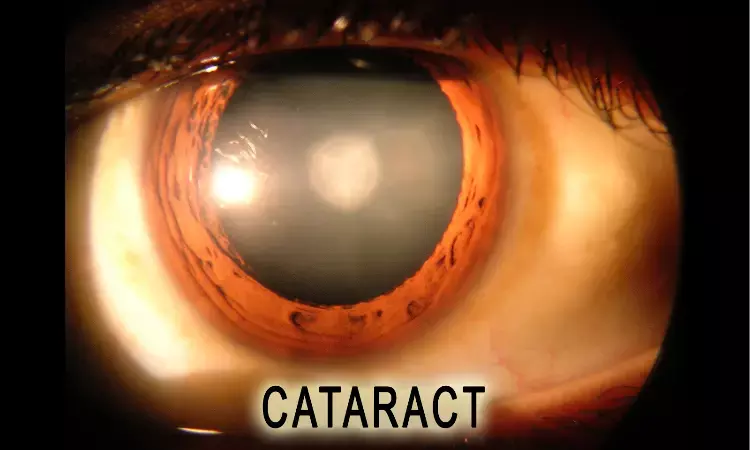- Home
- Medical news & Guidelines
- Anesthesiology
- Cardiology and CTVS
- Critical Care
- Dentistry
- Dermatology
- Diabetes and Endocrinology
- ENT
- Gastroenterology
- Medicine
- Nephrology
- Neurology
- Obstretics-Gynaecology
- Oncology
- Ophthalmology
- Orthopaedics
- Pediatrics-Neonatology
- Psychiatry
- Pulmonology
- Radiology
- Surgery
- Urology
- Laboratory Medicine
- Diet
- Nursing
- Paramedical
- Physiotherapy
- Health news
- Fact Check
- Bone Health Fact Check
- Brain Health Fact Check
- Cancer Related Fact Check
- Child Care Fact Check
- Dental and oral health fact check
- Diabetes and metabolic health fact check
- Diet and Nutrition Fact Check
- Eye and ENT Care Fact Check
- Fitness fact check
- Gut health fact check
- Heart health fact check
- Kidney health fact check
- Medical education fact check
- Men's health fact check
- Respiratory fact check
- Skin and hair care fact check
- Vaccine and Immunization fact check
- Women's health fact check
- AYUSH
- State News
- Andaman and Nicobar Islands
- Andhra Pradesh
- Arunachal Pradesh
- Assam
- Bihar
- Chandigarh
- Chattisgarh
- Dadra and Nagar Haveli
- Daman and Diu
- Delhi
- Goa
- Gujarat
- Haryana
- Himachal Pradesh
- Jammu & Kashmir
- Jharkhand
- Karnataka
- Kerala
- Ladakh
- Lakshadweep
- Madhya Pradesh
- Maharashtra
- Manipur
- Meghalaya
- Mizoram
- Nagaland
- Odisha
- Puducherry
- Punjab
- Rajasthan
- Sikkim
- Tamil Nadu
- Telangana
- Tripura
- Uttar Pradesh
- Uttrakhand
- West Bengal
- Medical Education
- Industry
Delayed sequential bilateral cataract surgery yields better refractive outcomes: JAMA

USA: Compared to delayed sequential bilateral cataract surgery (DSBCS-14) or DSBCS-90, immediate sequential bilateral cataract surgery (ISBCS) is associated with worse visual outcomes, a recent study has found. This may or may not be clinically significant depending on patients' additional risk factors.
The findings of this study were published in the journal JAMA Ophthalmology on 1st July 2021.
In the United States, around 2 million cataract surgeries are performed each year, and patterns of cataract surgery delivery are shifting to meet the rising demand. As a result, a comparison of visual acuity results following ISBCS vs delayed sequential bilateral cataract surgery (DSBCS) is critical for guiding future best practices. The purpose of this study was to examine the refractive results of patients who had ISBCS, short-interval (1-14 days between operations) DSBCS (DSBCS-14), and long-interval (15-90 days) DSBCS (DSBCS-90).
The American Academy of Ophthalmology Intelligent Research in Sight (IRIS) Registry was used for this retrospective cohort research. A total of 1 824 196 IRIS Registry patients who had bilateral visual acuity assessments and had bilateral cataract surgery were evaluated. Based on the time of the second eye operation, participants were separated into three groups (DSBCS-90, DSBCS-14, and ISBCS). The refractive results of the first and second surgery eyes were analyzed using univariable and multivariable linear regression models. Mean postoperative uncorrected visual acuity (UCVA) and best-corrected visual acuity (BCVA) following cataract surgery were the primary outcomes to be evaluated.
The key findings of this study are:
1. This research looked at data from 1824 196 people who had bilateral cataract surgery.
2. After age, self-reported race, insurance status, history of age-related macular degeneration, diabetic retinopathy, and glaucoma were controlled for, the UCVA of the first surgical eye was higher by 0.41 letters and the BCVA was higher by 0.89 letters in the DSBCS-14 group, whereas the UCVA was lower by 2.79 letters and the BCVA was lower by 1.64 letters in the ISBCS group.
3. Similarly, as compared to the DSBCS-90 group, the UCVA in the DSBCS-14 group was 0.79 letters higher and the BCVA was 0.48 letters lower, but in the ISBCS group, the UCVA was 1.67 letters lower and the BCVA was 1.88 letters higher.
In conclusion, ISBCS was shown to be related to poorer outcomes than DSBCS, despite the fact that the minor but statistically significant differences may not be clinically meaningful. The slight but statistically significant differences seen might be attributed to nonrandom surgical group assignment, confounding variables, and large sample size. More research is needed to evaluate if these criteria may be deemed clinically important when advising patients prior to cataract surgery.
Reference:
Owen JP, Blazes M, Lacy M, et al. Refractive Outcomes After Immediate Sequential vs Delayed Sequential Bilateral Cataract Surgery. JAMA Ophthalmol. 2021;139(8):876–885. doi:10.1001/jamaophthalmol.2021.2032
Medical Dialogues consists of a team of passionate medical/scientific writers, led by doctors and healthcare researchers. Our team efforts to bring you updated and timely news about the important happenings of the medical and healthcare sector. Our editorial team can be reached at editorial@medicaldialogues.in.
Dr Kamal Kant Kohli-MBBS, DTCD- a chest specialist with more than 30 years of practice and a flair for writing clinical articles, Dr Kamal Kant Kohli joined Medical Dialogues as a Chief Editor of Medical News. Besides writing articles, as an editor, he proofreads and verifies all the medical content published on Medical Dialogues including those coming from journals, studies,medical conferences,guidelines etc. Email: drkohli@medicaldialogues.in. Contact no. 011-43720751


